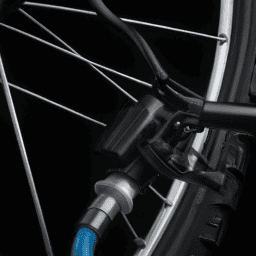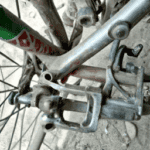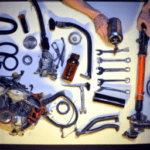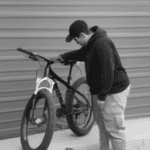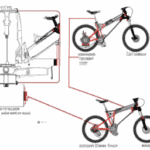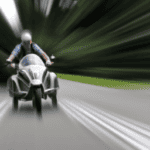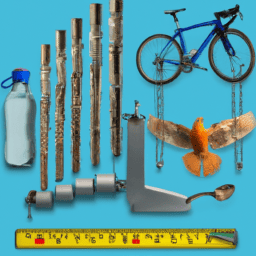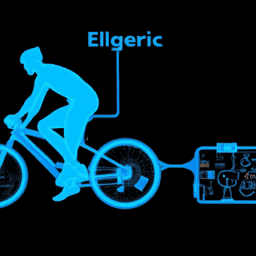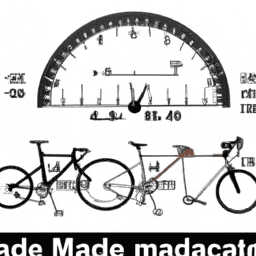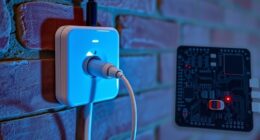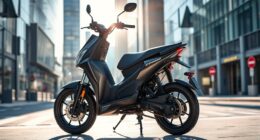Biking is akin to floating on air. It’s an indescribable sensation – the breeze flowing through your hair, the warmth of the sun kissing your face, and the boundless freedom of the open road ahead. But, what if I were to inform you that it’s possible to elevate that experience even further?
What if I told you that you could motorize your bicycle and become the king or queen of the road? Yes, my friend, it’s possible. With a little bit of know-how and some elbow grease, you can transform your trusty two-wheeler into a motorized machine.
In this article, I’ll guide you through the process of motorizing your bicycle, from choosing the right motor type to enjoying the fruits of your labor. So grab your tool kit and let’s get started!
Key Takeaways
- There are two types of motors for motorized bicycles: electric and gasoline, each with its own pros and cons.
- Choosing the right motor type and kit is crucial for optimizing performance and meeting individual needs.
- Regular maintenance and safety considerations are important for ensuring the longevity and safety of the motorized bicycle.
- Customization options and community events are available for those looking to personalize their motorized bicycles and connect with fellow enthusiasts.
Choose Your Motor Type
So, you wanna motorize your bicycle? Well, let’s start by choosing the type of motor that suits your needs!
The two most common types of motors are electric and gasoline. Electric motors are powered by batteries and are much quieter than gasoline motors, making them a great option for those who live in quiet neighborhoods or want to be more environmentally friendly. However, electric motors may not be as powerful as gasoline motors, and the batteries may need to be charged frequently depending on the distance you plan to travel.
On the other hand, gasoline motors are more powerful and can travel longer distances without needing to be refueled. However, they are much louder and emit fumes, which may not be ideal for those who live in urban areas or want to reduce their carbon footprint.
It’s important to weigh the pros and cons of each motor type before deciding which one to choose for your motorized bicycle.
Now that you’ve chosen your motor type, it’s time to select the kit that will best fit your bike.
Choose Your Kit
When you’re picking out your kit, you want to make sure it fits your needs, budget, and experience level. There are two main types of kits to choose from: electric and gas. Electric kits are becoming increasingly popular due to their eco-friendliness and ease of use, while gas kits offer more power and speed.
Factors to consider when choosing a kit include the type of riding you’ll be doing, the range you need, and the laws in your area regarding motorized bicycles. It’s also important to consider the quality and reputation of the kit manufacturer, as well as the price and any additional features such as battery capacity and charging time. To help you compare the different options, here’s a table outlining some of the key differences between electric and gas kits:
| Electric Kits | Gas Kits |
|---|---|
| Quieter | Louder |
| No emissions | Emit fumes |
| Lower top speed | Higher top speed |
| Slower acceleration | Faster acceleration |
| Requires charging time | Requires refueling time |
Choosing the right kit for your needs is crucial to ensure a successful and enjoyable motorized bicycle experience. Once you’ve picked out your kit, it’s time to move on to the installation process and get started on building your motorized bicycle.
Installation Process
To install your chosen kit, you’ll need to start by gathering your tools and carefully following the manufacturer’s instructions to ensure a smooth and safe process. Here are the tools required for the installation process:
-
Wrenches: Depending on the type of kit you’ve chosen, you may need a combination wrench, an adjustable wrench, or both. These are essential tools for loosening and tightening bolts and nuts.
-
Screwdrivers: You’ll need a set of screwdrivers, including a flathead and a Phillips head, to remove and install screws.
-
Pliers: Needle-nose pliers are useful for reaching into tight spaces, while slip-joint pliers are ideal for gripping and turning objects of various sizes.
One of the most common mistakes people make during the installation process is not tightening bolts and nuts enough. This can lead to loose connections, which can be dangerous when you’re riding. You should also avoid over-tightening, as this can strip threads and cause damage to your bike.
With careful attention to detail and the right tools, however, you can successfully install your kit and enjoy a new level of cycling freedom. As you move forward, keep in mind that regular maintenance and safety considerations are crucial for keeping your motorized bicycle running smoothly and safely.
Maintenance and Safety Considerations
Don’t skimp on maintenance and safety procedures if you want to keep your new ride in tip-top shape and avoid any potential mishaps. It’s important to take preventative measures to ensure that your motorized bicycle runs smoothly and safely.
This includes performing regular maintenance checks, such as inspecting the brakes, tires, and chain, as well as checking the oil and fuel levels. You should also be sure to wear proper safety gear, such as a helmet and reflective clothing, and follow all traffic laws.
It’s also a good idea to create a maintenance schedule and stick to it. This will help you stay on top of any necessary repairs or maintenance tasks, and ensure that your motorized bicycle stays in good condition.
Additionally, be sure to follow any manufacturer recommendations for maintenance and safety procedures. By following these guidelines, you’ll be able to enjoy your motorized bicycle for years to come, with the peace of mind that comes with knowing you’re riding safely and responsibly.
Enjoying Your Motorized Bicycle
I’m excited to finally try out my new motorized bicycle! Before I hit the road, I want to make sure I have some tips for safe and fun riding.
I’m also looking forward to exploring new opportunities and uses for my motorized bicycle, such as commuting to work or taking it on a leisurely weekend ride.
Trying Out Your New Ride
Once you’ve got your motorized bicycle up and running, take it for a spin and feel the wind in your hair! Before hitting the road, make sure you have your helmet on and all safety precautions are in place.
Your new ride is not only fun, but also a great way to commute and save on gas expenses. If you’re looking to add some personal touches to your motorized bicycle, there are plenty of customization options available. You can paint the frame, add decals or even install a new seat.
Upgrading components such as the brakes, suspension or tires can also improve your riding experience. Just remember to always prioritize safety when making any modifications.
Now that you’re ready to hit the road on your motorized bicycle, let’s explore some tips for safe and fun riding.
Tips for Safe and Fun Riding
Now that you’ve tried out your new motorized bicycle, it’s time to focus on safe and fun riding. It’s important to wear the proper attire when riding, including a helmet and reflective clothing. This will not only protect you in case of an accident, but also make you more visible to other drivers on the road. Make sure to also wear comfortable shoes and avoid loose clothing that may get caught in the gears or chain.
Route planning is another crucial aspect of safe riding. Before heading out, plan your route and make sure to choose roads that are bicycle-friendly and have designated bike lanes. Avoid busy highways and roads with heavy traffic.
It’s also a good idea to familiarize yourself with the local traffic laws and regulations for bicycles. Always signal your turns and follow traffic signals and signs.
By following these tips, you can ensure a safe and enjoyable riding experience on your motorized bicycle. With proper attire and route planning, you can explore new opportunities and uses for your motorized bicycle without having to worry about safety concerns.
Exploring New Opportunities and Uses for Your Motorized Bicycle
Discovering fresh possibilities and ways to utilize your motorized bike can add excitement and adventure to your daily routine.
One of the best ways to get more out of your motorized bike is to check out the different customization options available. You can add new features like a basket or a rack to carry your groceries, or install a GPS tracking system for added security. You can also swap out parts like the seat or handlebars for a more comfortable ride.
Whether you’re commuting to work or exploring new paths in your neighborhood, these customizations can make your motorized bike more functional and enjoyable. In addition to customization options, there are also community events that can help you get more out of your motorized bike.
Look for local groups or clubs that organize rides, races, or other events centered around motorized bikes. Not only will you get to meet other enthusiasts and learn from their experiences, but you’ll also get to explore new areas and challenge yourself in new ways. Whether you’re a seasoned veteran or a beginner, these events offer a great opportunity to take your motorized bike to the next level and make the most of your investment.
Frequently Asked Questions
Can I use a motorized bicycle on public roads and highways?
I found that 47 states in the US allow motorized bicycles on public roads and highways, but legal regulations vary. As for environmental impact, it depends on the type of motor and fuel used. It’s important to follow local laws and consider eco-friendly options.
How much does it cost to convert a regular bicycle into a motorized bicycle?
Converting a bike into a motorized one can cost anywhere from $200 to $2000 depending on factors such as DIY or professional conversion, type of motor, battery, and other accessories.
Do I need a license or insurance to ride a motorized bicycle?
I’m happy to report that no license or insurance is required to ride a motorized bicycle in most states. However, it’s important to check local laws and regulations as they may vary.
How far can I travel on a single charge or tank of gas with a motorized bicycle?
On my motorized bicycle, I can travel up to 50 miles on a single charge with a lithium ion battery. With a full tank of gas, I can travel up to 100 miles. The travel range and battery life depend on the specific motor and battery used.
Can I still pedal my motorized bicycle like a regular bicycle if I run out of gas or the battery dies?
Yes, if my motorized bike runs out of gas or the battery dies, I can still pedal it like a regular bike. Pedaling benefits include exercise and conserving energy. However, the added weight of the motor may make pedaling more difficult.
Conclusion
In conclusion, motorizing your bicycle is a fun and exciting way to take your cycling experience to the next level. However, it’s important to choose the right motor type and kit for your needs, and to follow the installation process carefully. Once you have your motorized bicycle set up, remember to perform regular maintenance and follow safety considerations to ensure a smooth and safe ride.
But the true joy of motorizing your bicycle comes from the freedom it provides. Imagine cruising down the road with the wind in your hair, feeling the power of the motor as you effortlessly conquer hills and distances that once seemed daunting.
With a motorized bicycle, the possibilities are endless, and the adventures are waiting to be had. So what are you waiting for? Get started on your motorized bicycle journey today, and experience the thrill of the ride like never before.
